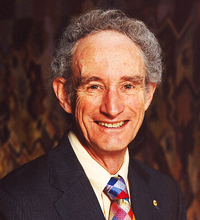Royal Society of NSW News & Events
Death of Lord Robert May of Oxford-Distinguished Fellow of the Royal Society of NSW
 The Society is saddened to learn of the death of one of its Distinguished Fellows, Lord May of Oxford, OM AC Kt FRS DistFRSN FAA FTSE HonFAIB, on 28 April 2020, aged 84. Lord May was a pioneering Australian scientist whose work in biology led to the development of chaos theory. He was one of Australia's most accomplished scientists, being elevated to the peerage in 2001, and rising to serve as the Chief Scientific Advisor to the United Kingdom Government (1995–2000), and as President of the Royal Society (2000–05).
The Society is saddened to learn of the death of one of its Distinguished Fellows, Lord May of Oxford, OM AC Kt FRS DistFRSN FAA FTSE HonFAIB, on 28 April 2020, aged 84. Lord May was a pioneering Australian scientist whose work in biology led to the development of chaos theory. He was one of Australia's most accomplished scientists, being elevated to the peerage in 2001, and rising to serve as the Chief Scientific Advisor to the United Kingdom Government (1995–2000), and as President of the Royal Society (2000–05).
Born in Sydney on 8 January 1936, he completed his PhD in theoretical physics at the University of Sydney in 1959, before taking a lectureship in applied mathematics at Harvard University (1959–61) and subsequently returning to the University of Sydney in 1962 where he was appointed to a Chair in Theoretical Physics, in 1969, at the age of 33. His career then took him to Princeton where, as Professor of Zoology, he made pioneering advances during the 70s and 80s in the field of population biology through the application of advanced mathematical techniques. He played a key role in the development of the field of theoretical ecology, subsequently applying these methods to the study of disease and biodiversity. From 1988 to 1995 he held a Royal Society Research Professorship at Imperial College and the University of Oxford, where he became a Fellow of Merton College.
He was awarded a Knighthood in 1996 and was appointed a Companion of the Order of Australia in 1998, both for “services to science” In 2001, he was one made of the first 15 Life Peers created by the House of Lords Appointments Commission, while in 2002, Her Majesty The Queen appointed him to the Order of Merit—only the ninth Australian in its 100-year history.
His many honours included the Royal Swedish Academy’s Crafoord Prize; the Swiss-Italian Balzan Prize; and the Japanese Blue Planet Prize. He was a Foreign Member of the US National Academy of Sciences, an Overseas Fellow of the Australian Academy of Sciences, an Honorary Fellow of the Royal Academy of Engineering and several other Academies and Learned Societies in the UK, USA and Australia, and a Distinguished Fellow of the Royal Society of NSW. In 2007, he received the Royal Society's Copley Medal, its oldest (1731) and most prestigious award, given annually for “outstanding achievements in research in any branch of science”.
Tributes to the passing of a truly gifted polymath whose achievements spanned biology, physics and public policy can be read in his obituary in the Guardian. Other obituaries and links to his achievements can be found in Lord May's entry on the Late Distinguished Fellows page.

